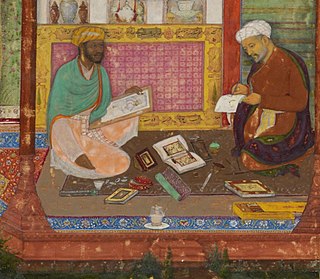 W
WBengali literature denotes the body of writings in the Bengali language. Bengali has developed over the course of roughly 1,300 years. The earliest extant work in Bengali literature is the Charyapada, a collection of Buddhist mystic songs in Old Bengali dating back to the 10th and 11th centuries. The timeline of Bengali literature is divided into three periods − ancient (650-1200), medieval (1200-1800) and modern. Medieval Bengali literature consists of various poetic genres, including Hindu religious scriptures, Islamic epics, Vaishnava texts, translations of Arabic, Persian and Sanskrit texts, and secular texts by Muslim poets. Novels were introduced in the mid-19th century. Nobel Laureate Rabindranath Tagore is the best known figure of Bengali literature to the world. Kazi Nazrul Islam, notable for his activism and anti-British literature, was described as the Rebel Poet and is now recognised as the National poet of Bangladesh.
 W
WA chapbook is a small publication of up to about 40 pages, sometimes bound with a saddle stitch.
 W
WContes et nouvelles en vers is an anthology of various ribald short stories and novellas collected and versified from prose by Jean de La Fontaine. Claude Barbin of Paris published the collection in 1665.
 W
WThe Davenport Group is the informal name of a nationally known group of early modernist writers who first came together in Davenport, Iowa. In the early 20th century, they migrated east to New York City to assume leading roles in several important artistic and cultural developments in the 1910s and 1920s. Core members of the group are Susan Glaspell, her husband George Cram Cook, who were among the founders of the Provincetown Players; Floyd Dell, and Arthur Davison Ficke. Other Davenport writers associated with the group include Alice French, Charles Eugene Banks, Nilla Cram Cook, and Harry Hansen.
 W
WIn Islamic cultures of the Middle East, North Africa, Sicily and South Asia, a Diwan is a collection of poems by one author, usually excluding his or her long poems (mathnawī). These poems, frequently sung or set to music, were often composed and collected in the imperial courts of various sultanates and were very well known for their ability to inspire. In modern-times, the inspirational, linguistic, verse, meter, and other design features of the Diwan or Masnavi poetry, are found echoing in other cultures, same or similar to the relaying of hidden messages, safety, and support, left for those ex-slaves on the Underground Railroad, during the American Civil War. Thus, themes that emerge from traditional Islamic origins can again portray of and evoke the persistence of life, or whatever continuances, admirable to the old or traditional ways and wisdoms. Where these are found in freeform variants, like an enigma, the modern Diwan, as powers brings a peculiar message encompassing for the divinities.
 W
WFalnama is a book of omens used by fortune tellers in Iran and Turkey during the 16th and 17th centuries. Individuals seeking insight into the future would engage in a series of purification rituals, turn to a random page in the Falnama, and interpret the text and drawings thereon for good or ill. Falnama manuscripts were primarily created during the 16th and 17th centuries as the Islamic calendar was approaching the year 1000.
 W
WMysore literature in Kannada is a body of literature composed in the Kannada language in the historical Kingdom of Mysore in Southern India and written in the Kannada script. The writings date from the Kingdom of Mysore, which existed from around 1600 CE until the establishment of modern India in 1947. Many of the works of this literature written on religious themes are labeled Veerashaiva or Vaishnava in acknowledgment of the two faiths that gave form to the literature and fostered it until the advent of the modern era. Despite a gradual decline in the popularity of Jainism, authors devoted to the faith produced some works of merit. Secular themes dealing with a wide range of subjects were also written on. Kannada literature flourished for a short while in the court of the neighbouring kingdom of the Nayakas of Keladi whose territory was annexed by Mysore in 1763.
 W
WLiterature in early modern Scotland is literature written in Scotland or by Scottish writers between the Renaissance in the early sixteenth century and the beginnings of the Enlightenment and Industrial Revolution in mid-eighteenth century. By the beginning of this era Gaelic had been in geographical decline for three centuries and had begun to be a second class language, confined to the Highlands and Islands, but the tradition of Classic Gaelic Poetry survived. Middle Scots became the language of both the nobility and the majority population. The establishment of a printing press in 1507 made it easier to disseminate Scottish literature and was probably aimed at bolstering Scottish national identity.
 W
WTamil literature has a rich and long literary tradition spanning more than two thousand years. The oldest extant works show signs of maturity indicating an even longer period of evolution. Contributors to the Tamil literature are mainly from Tamil people from South India, including the land now comprising Tamil Nadu, Kerala, Sri Lankan Tamils from Sri Lanka, as well as the Tamil diaspora.